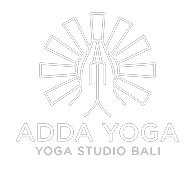VINYASA YOGA
More flowing style, dynamic, including sequencing and link between asanas and a strong emphasis
between breath and movement. Power Vinyasa involves longer hold, and faster movement perform in a
more athletic way.
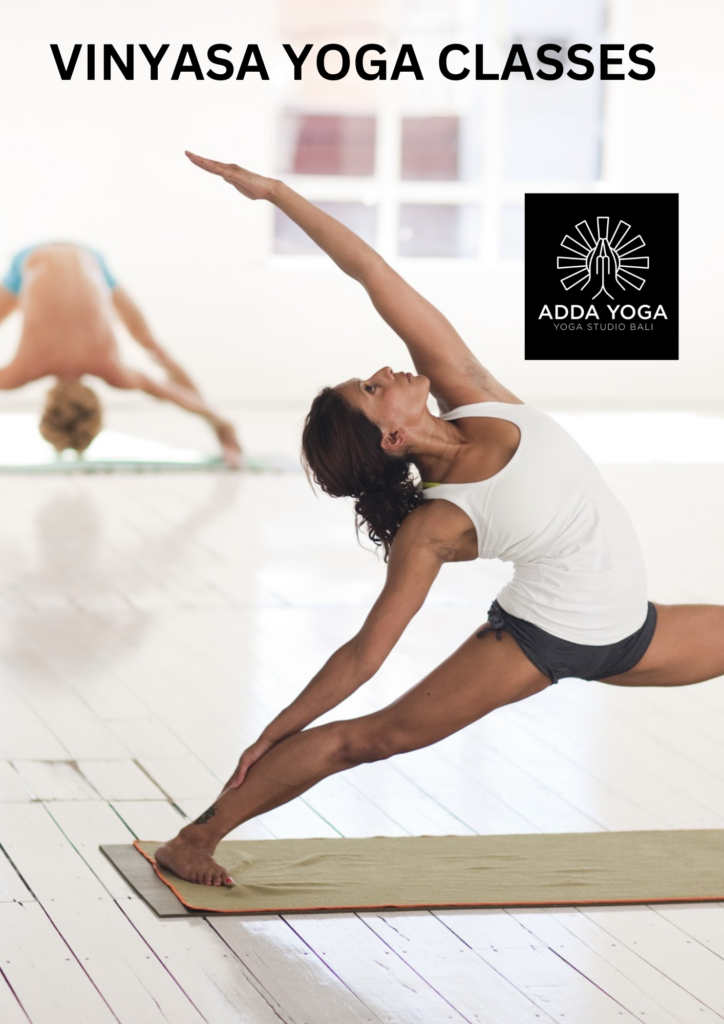
Vinyasa Yoga Classes Bali, Canggu and Seminyak
If you’ve only recently begun taking Yoga lessons at your favourite studio, you might have noticed a strange term that keeps appearing repeatedly. Vinyasa. You could be perplexed if you haven’t spent much time in a Yoga studio.
But don’t worry, we have covered you all with our comprehensive guide to vinyasa yoga. So let’s proceed with a list of questions that mostly every newbie asks.
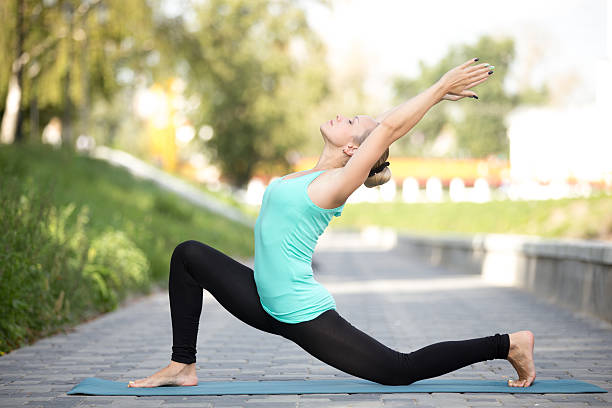

What is Vinyasa Yoga?
Vinyasa is the opposite of Hatha. In Hatha classes, one position is typically emphasized at a time, with breaks in between.
Whereas in Vinyasa flow classes, yoga poses are combined to create a sequence.
Vinyasa is frequently referred to as “flow” yoga and is occasionally called Vinyasa Flow.
Each motion in vinyasa yoga is timed to a breath. Here, priority is given to the breath, which serves as an anchor as you transition from one pose to the next.
There are many different postures available in vinyasa classes, and no two are ever the same.
For example – A pretty simple vinyasa flow is like the cat-cow stretch. On inhalation, the spine is arched on exhalation, it is rounded.
And a more complicated vinyasa flow is one round of sun salutation.
Breathing in or out serves as the signal for each action in the series.
Origin & History of Vinyasa Yoga
As this yoga style first originated in ancient India, the Sanskrit word Vinyasa literally translates to “connection.”
This can be understood in terms of yoga asana as a link between movement and breath or as the link between positions in a flowing sequence.
There is no established lineage, hierarchy, or head guru in vinyasa yoga or vinyasa flow, meaning it is not a system.
The practice of vinyasa yoga has no recognized originator.
The Ashtanga Vinyasa Yoga tradition gave rise to the contemporary yoga form known as Vinyasa.
Sri Krishnamacharya’s teachings serve as the foundation for the Ashtanga Vinyasa tradition.
According to Krishnamacharya, the transitions between each asana are just as important as the postures themselves.
His goal was to increase body awareness and concentration during the entire session.
In Vinyasa Yoga, the objective is to maintain deep breathing and body mindfulness throughout all movements during the practice rather than concentrating on “getting into the pose” and breathing.
How to Practice Vinyasa Yoga?
- Vinyasa poses need you to coordinate your movement with your breathing, which can be complex and confusing at first. However, vinyasa can ultimately enhance your focus and awareness once you get the hang of it and find a rhythm that suits your body.
- In order to keep up with the pace of the class, it is acceptable to take more breaths or to slow down and skip some motions if you are having trouble breathing.
- Instead of focusing on particular poses or specifics, give yourself permission to sink into the practice’s rhythm and flow.
- Do not force yourself into unfamiliar positions as you proceed through your vinyasa session. For example, if every one of your classmates can do a Headstand, and it’s too soon for you to reach there, then you don’t have to.
- Respect your present capabilities appropriately, and if you need to take a break, do so without hesitation. Taking a break is totally acceptable! It’s also respected because it demonstrates that someone is caring for themselves.
Technical Details of Vinyasa Practice and Teaching Vinyasa Yoga
Every vinyasa class will likely begin with a phase of setting intentions and conclude with a final relaxation.
The structure, tempo, and other elements, however, will vary from class to class in between.
In certain vinyasa sessions, the instructor could speak about postures and assume that everyone in the class knows how to perform them.
In other vinyasa classes, such as beginners focusing on alignment, teachers will give more detailed instructions on holding each posture.
Additionally, there are heated vinyasa studios and vinyasa courses that incorporate yin or restorative yoga as well as other styles of yoga.
How is Vinyasa Yoga Different from Other Yoga Forms?
We’ve said above that Ashtanga Yoga is commonly confused with “Vinyasa Flow Yoga,” so how precisely are they dissimilar?
Ashtanga employs a set series of postures, always the same, depending on the series that are meant to be performed daily. When the instructor determines that a student is ready, the sequence is gradually expanded.
The pupil is expected to memorize the sequence and perform it at their own breathing rhythm because the sequence is predetermined.
On the other hand, Vinyasa Yoga nearly typically follows a led, class-based approach.
Teachers create imaginative sequences designed to treat problems, work particular body areas, or progress to the most advanced positions and movements.
Although many teachers have pioneered their fixed sequences that they may cycle throughout the week, month, or year, vinyasa yoga sessions are still very unique from class to class.
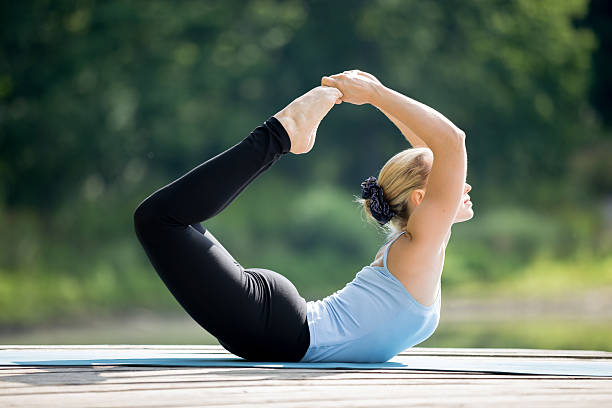
Health Benefits of Vinyasa Yoga
There are some vital health benefits of vinyasa yoga, including:
- Reducing Stress
- Improving Sleep Quality
- Boosting the Immune System
- Increasing Energy Levels
- Promoting Weight Loss
- Improve Cardiovascular Health
- Enhances your Respiratory System
- Increase Overall Flexibility and Strength
If you’re looking for a workout that is both challenging and relaxing, vinyasa yoga is a great option.
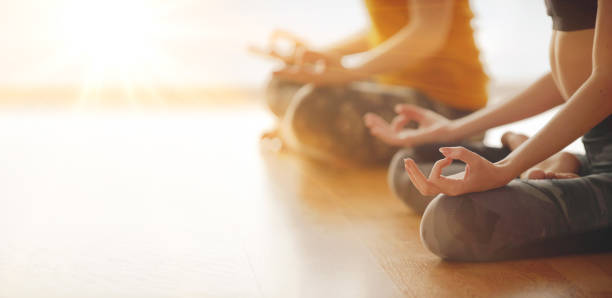
Why Vinyasa is a Flowing Type of Yoga?
Vinyasa yoga is a flowing type of yoga because it emphasizes movement and breath. The word “vinyasa” means “to connect in a special way,” and the practice is often called “flow” yoga because of the continuous flow of movement.
Vinyasa Flow, often known as flow yoga, is a form of yoga that focus on transitions and movements rather than spending a lot of time in still positions.
Your entire body will frequently be worked throughout a Vinyasa flow session, and you’ll likely increase your range of motion by moving differently than you usually would.
If you’re looking for a workout that is both challenging and relaxing, vinyasa yoga is a great option.

The power Vinyasa experience
If your main goal is to become stronger with your yoga practice, then Power Vinyasa is the way to go!
Power Vinyasa is the strongest form of yoga that will burn higher amounts of calories with an intense pace of flowing throughout.
The intensity allows you to keep the heartbeat up and helps you enhance your physical, mental, and emotional stamina.

Vinyasa Yoga in Bali, Canggu, Seminyak
If you are looking for Yoga classes in Bali, ADDA YOGA has a wide range of quality classes, going from different lineages, style, speed and focusing on different aspects of the Yogic philosophy and practice . We aimed to not only concentrate on the physical part of Yoga, but to have a wider view and that our student understand practice breathing, meditation, understand the Yoga philosophy to go deeper in their mindful practice.
We have numerous Vinyasa classes, going from Slow Flow Vinyasa, Vinyasa Flow, Power Vinyasa.
Come and join us for a quality practice in our friendly yoga studio!

